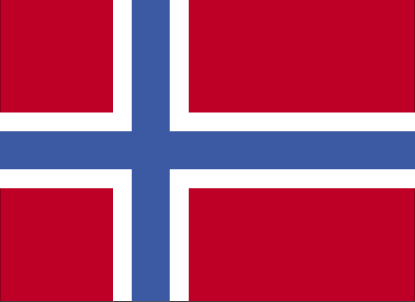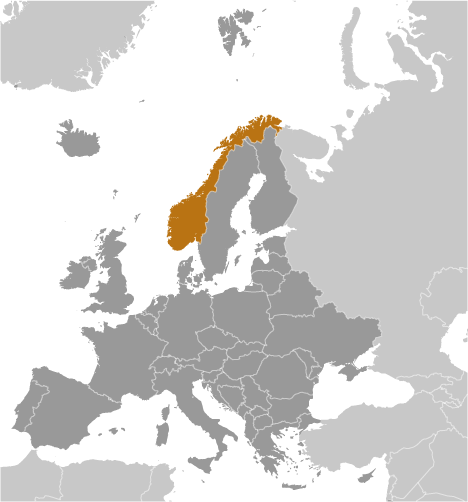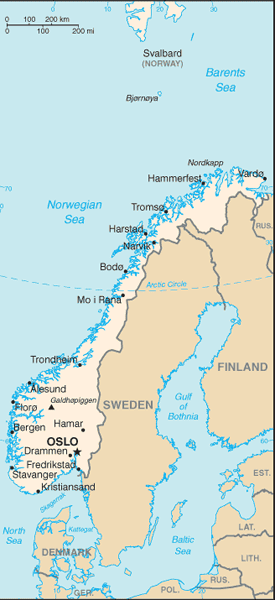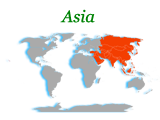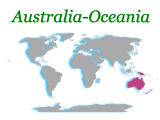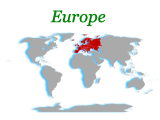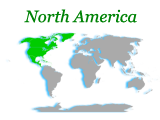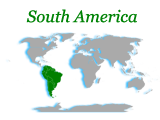Two centuries of Viking raids into Europe tapered off following the adoption of Christianity by King Olav TRYGGVASON in 994. Conversion of the Norwegian kingdom occurred over the next several decades. In 1397, Norway was absorbed into a union with Denmark that lasted more than four centuries. In 1814, Norwegians resisted the cession of their country to Sweden and adopted a new constitution. Sweden then invaded Norway but agreed to let Norway keep its constitution in return for accepting the union under a Swedish king. Rising nationalism throughout the 19th century led to a 1905 referendum granting Norway independence. Although Norway remained neutral in World War I, it suffered heavy losses to its shipping. Norway proclaimed its neutrality at the outset of World War II, but was nonetheless occupied for five years by Nazi Germany (1940-45). In 1949, neutrality was abandoned and Norway became a member of NATO. Discovery of oil and gas in adjacent waters in the late 1960s boosted Norway's economic fortunes. The current focus is on containing spending on the extensive welfare system and planning for the time when petroleum reserves are depleted. In referenda held in 1972 and 1994, Norway rejected joining the EU.
Country Name
Conventional long form:Kingdom of Norway
Conventional short form:Norway
Local long form:Kongeriket Norge
Local short form:Norge
Government Type
constitutional monarchy
Capital
Name:Oslo
Geographic coordinates:59 55 N, 10 45 E
Time difference:UTC+1 (6 hours ahead of Washington, DC during Standard Time)
daylight saving time: +1hr, begins last Sunday in March; ends last Sunday in October
Administrative divisions
19 counties (fylker, singular - fylke); Akershus, Aust-Agder, Buskerud, Finnmark, Hedmark, Hordaland, More og Romsdal, Nordland, Nord-Trondelag, Oppland, Oslo, Ostfold, Rogaland, Sogn og Fjordane, Sor-Trondelag, Telemark, Troms, Vest-Agder, Vestfold
Independence
7 June 1905 (Norway declared the union with Sweden dissolved); 26 October 1905 (Sweden agreed to the repeal of the union)
National Holiday
Constitution Day, 17 May (1814)
Constitution
17 May 1814; amended many times
Legal system
mixture of customary law, civil law system, and common law traditions; Supreme Court renders advisory opinions to legislature when asked; accepts compulsory ICJ jurisdiction with reservations
Suffrage
18 years of age; universal
Executive branch
Chief of state:King HARALD V (since 17 January 1991); Heir Apparent Crown Prince HAAKON MAGNUS, son of the monarch (born 20 July 1973)
Head of government:Prime Minister Jens STOLTENBERG (since 17 October 2005)
Cabinet:State Council appointed by the monarch with the approval of parliament
(For more information visit the World Leaders website)
Elections: the monarchy is hereditary; following parliamentary elections, the leader of the majority party or the leader of the majority coalition usually appointed prime minister by the monarch with the approval of the parliament
Legislative branch
modified unicameral Parliament or Storting (169 seats; members elected by popular vote by proportional representation to serve four-year terms)
Elections:last held on 14 September 2009 (next to be held in September 2013)
Election results:percent of vote by party - DNA 35.4%, FrP 22.9%, H 17.2%, SV 6.2%, Sp 6.2%, KrF 5.5%, V 3.9%, other 2.7%; seats by party - DNA 64, FrP 41, H 30, SV 11, Sp 11, KrF 10, V 2
note: for certain purposes, the parliament divides itself into two chambers and elects one-fourth of its membership in the Lagting and three-fourths of its membership in the Odelsting
Judicial branch
Supreme Court or Hoyesterett (justices appointed by the monarch)
Political Parties and Leaders
Center Party (Senterpartiet or Sp) [Liv Signe NAVARSETE]; Christian People's Party (Kristelig Folkeparti or KrF) [Dagfinn HOYBRATEN]; Conservative Party (Hoyre or H) [Erna SOLBERG]; Labor Party (Det norske Arbeiderpartiet or DNA) [Jens STOLTENBERG]; Liberal Party (Venstre or V) [Lars SPONHEIM]; note - has announced his resignation; Progress Party (Framstegspartiet or FrP) [Siv JENSEN]; Socialist Left Party (Sosialistisk Venstreparti or SV) [Kristin HALVORSEN]
Political pressure groups and leaders
Norwegian Aid Committee or NORWAC; Norwegian Association of the Disabled; Pure Salmon Campaign; The Consumer Council (consumer advocacy group)
Other:environmental groups; media; reform movements
International organization participation
ADB (nonregional member), AfDB (nonregional member), Arctic Council, Australia Group, BIS, CBSS, CE, CERN, EAPC, EBRD, EFTA, ESA, FAO, FATF, IADB, IAEA, IBRD, ICAO, ICC, ICCt, ICRM, IDA, IEA, IFAD, IFC, IFRCS, IHO, ILO, IMF, IMO, IMSO, Interpol, IOC, IOM, IPU, ISO, ITSO, ITU, ITUC, MIGA, MINURCAT, MONUC, NATO, NC, NEA, NIB, NSG, OAS (observer), OECD, OPCW, OSCE, Paris Club, PCA, Schengen Convention, UN, UNCTAD, UNESCO, UNHCR, UNIDO, UNITAR, UNMIS, UNRWA, UNTSO, UNWTO, UPU, WCO, WFTU, WHO, WIPO, WMO, WTO, ZC
Diplomatic representation in the US
Chief of mission:Ambassador Wegger C. STROMMEN
Chancery:2720 34th Street NW, Washington, DC 20008
Telephone:[1] (202) 333-6000
FAX:[1] (202) 337-0870
Consulate(s) general:Houston, New York, San Francisco
Diplomatic representation from the US
Chief of mission:Ambassador Barry B. WHITE
Embassy:Henrik Ibsens gate 48, 0244 Oslo; note - the embassy will move to Huseby in the near future
Mailing address:PSC 69, Box 1000, APO AE 09707
Telephone:[47] (22) 44 85 50
FAX:[47] (22) 44 33 63, 56 27 51
Flag description
red with a blue cross outlined in white that extends to the edges of the flag; the vertical part of the cross is shifted to the hoist side in the style of the Dannebrog (Danish flag); the colors recall Norway's past political unions with Denmark (red and white) and Sweden (blue)
